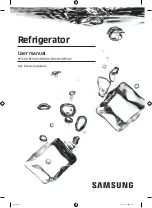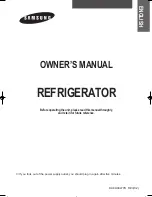
Freezing foods/storing frozen foods
Freezing food has a positive effect on its shelf
life. You can also avoid food waste in this way.
• Set the temperature in the freezer com-
partment to –18 °C. In doing so, the tem-
perature conditions inside are optimally
utilised, guaranteeing optimal food stor-
age:
– Place food to be frozen in the freezer
drawer (6).
• Combine the drawers as shown in the di-
agram on page EN-4 to achieve the most
efficient use of energy for your appliance.
Preparing food
• Only freeze high quality food.
• Freeze fresh and prepared food dry and
unseasoned. Unsalted foods are more
durable.
• Allow prepared food to cool before freez-
ing. This not only saves power, but also
prevents excessive frost formation in the
freezer.
• Carbonated drinks are not suitable for
freezing because the carbon dioxide es-
capes during freezing.
Suitable packaging
Packaging is important when freezing. This
will protect against oxidation, penetration by
microbes, transfer of odours and flavourings
and drying out (freezer burn).
• Only use packaging material that is
strong, impermeable to air and liquid, not
too stiff and labelled. It should be desig-
nated as suitable for freezer use.
• Use plastic clips, rubber bands or adhe-
sive tapes to seal.
Portions
• Use flat portions as much as possible;
these freeze through to the core faster.
• Expel the air from the freezer bag as this
causes the contents to dry out and takes
up space.
• Fill liquid containers no more ¾ full, be-
cause liquids expand when frozen.
Do not store glass or metal containers con-
taining liquids such as water, lemonade,
beer, etc. Water expands when frozen and
may burst the container. Only high percent-
age alcohol (from 40% volume) should be
frozen; make sure that it is tightly sealed.
• Label the frozen food by type, quantity,
amount and expiry date. Use waterproof
marker pens or adhesive labels wherever
possible.
Freezing capacity
Once the freezer temperature is –18 °C, you
can freeze fresh, room-temperature foods.
You will find the freezing capacity for your ap-
pliance on the appliance's type plate.
• Adhere to the maximum freezing capacity
if possible.
Up to the indicated maximum freezing
capacity:
If you adhere to the maximum freezing ca-
pacity, the food will freeze at the fastest rate.
The temperature in the freezer briefly rises af-
ter placing fresh goods inside. After 12 hours,
the goods are frozen to the core.
Above the indicated maximum freezing
capacity:
If you want to freeze more food in one go as
an exception, freezing will take longer. Keep
fresh goods out of contact with existing fro-
zen foods, as the frozen foods could start
to defrost. If contact with stored food cannot
be avoided, we recommend that you create
a cold reserve in the freezer before freez-
ing the fresh goods (see ‘Rapid-freezing’ on
page EN-13).
Freezing foods/storing frozen foods
Page EN-18













































